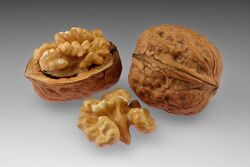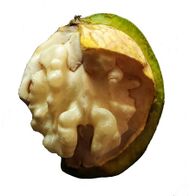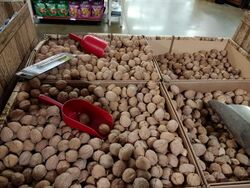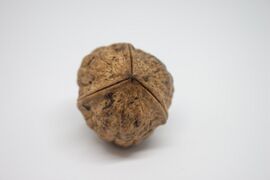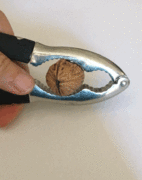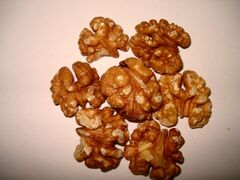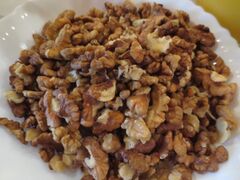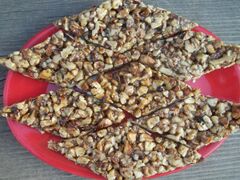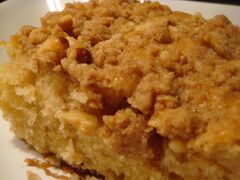Walnut
Topic: Biology
 From HandWiki - Reading time: 11 min
From HandWiki - Reading time: 11 min
A walnut is the edible seed of any tree of the genus Juglans (family Juglandaceae), particularly the Persian or English walnut, Juglans regia. They are accessory fruit because the outer covering of the fruit is technically an involucre and thus not morphologically part of the carpel; this means it cannot be a drupe but is instead a drupe-like nut.
After full ripening, the shell is discarded, and the kernel is eaten. Nuts of the eastern black walnut (Juglans nigra) and butternuts (Juglans cinerea) are less commonly consumed.
Description
Walnuts are the round, single-seed stone fruits of the walnut tree. They ripen between September and November in the northern hemisphere. The brown, wrinkly walnut shell is enclosed in a husk.[1] Shells of walnuts available in commerce usually have two segments (but three or four-segment shells can also form). During the ripening process, the husk becomes brittle and the shell hard. The shell encloses the kernel or meat, which is usually in two halves separated by a membranous partition.[1] The seed kernels – commonly available as shelled walnuts – are enclosed in a brown seed coat which contains antioxidants. The antioxidants protect the oil-rich seed from atmospheric oxygen, preventing rancidity.[2]
Walnut trees are late to grow leaves, typically not doing so until more than halfway through the spring.
Chemistry
Walnut hulls contain diverse phytochemicals, such as polyphenols, that stain hands and can cause skin irritation. Seven phenolic compounds, including ferulic acid, vanillic acid, coumaric acid, syringic acid, myricetin, and juglone, were identified in walnut husks; juglone had concentrations of 2-4% fresh weight.[3]
Walnuts also contain the ellagitannin, pedunculagin.[4] Regiolone has been isolated with juglone, betulinic acid and sitosterol from the stem bark of J. regia.[5]
Similar species
Species
The three species of walnuts most commonly grown for their seeds are the Persian (or English) walnut (J. regia), originating from Iran, the black walnut (J. nigra) – native to eastern North America – and the Japanese walnut, also known as the heartnut (J. ailantifolia).[6] Other species include J. californica, the California black walnut (often used as a rootstock for commercial propagation of J. regia), J. cinerea (butternuts), and J. major, the Arizona walnut. Other sources list J. californica californica as native to southern California, and Juglans californica hindsii, or just J. hindsii, as native to northern California; in at least one case, these are given as "geographic variants" instead of subspecies (Botanica).[citation needed]
Numerous walnut cultivars have been developed commercially, which are nearly all hybrids of the English walnut.[7]
The black walnut is of strong flavor, but due to its hard shell and poor hulling characteristics, it is not commercially cultivated in orchards.[citation needed]
| Country | Production (millions of tonnes) |
|---|---|
| 1.10 | |
| 0.66 | |
| 0.39 | |
| 0.33 | |
| 0.14 | |
| World | 3.50 |
| Source: FAOSTAT of the United Nations[8] | |
Cultivation
In 2021, world production of walnuts (in shell) was 3.5 million tonnes, with China contributing 31% of the total (table). Other major producers (in the order of decreasing harvest) were the United States, Iran, and Turkey.[8]
History
During the Byzantine era, the walnut was also known by the name "royal nut".[9] An article on walnut tree cultivation in Spain is included in Ibn al-'Awwam's 12th-century Book on Agriculture.[10] The wal element in the name is Germanic and means foreign, especially in the sense of Latin or non-Germanic. Compare, for example, Wales, Walloons, Wallachia. The wal element is present in other Germanic-language words for the same nut, such as: German Walnuss, Dutch walnoot, Danish valnød, and Swedish valnöt.
Storage
Walnuts, like other tree nuts, must be processed and stored properly. Poor storage makes walnuts susceptible to insect and fungal mold infestations; the latter produces aflatoxin – a potent carcinogen. A batch that contains mold-infested walnuts should be entirely discarded.[2]
The ideal temperature for the extended storage of walnuts is −3 to 0 °C (27 to 32 °F) with low humidity for industrial and home storage. However, such refrigeration technologies are unavailable in developing countries where walnuts are produced in large quantities; walnuts are best stored below 25 °C (77 °F) with low humidity. Temperatures above 30 °C (86 °F) and humidity levels above 70 percent can lead to rapid and high spoilage losses. Above 75 percent humidity threshold, fungal molds that release dangerous aflatoxin can form.[2][11]
Cultivars
Uses
Culinary
Walnut meats are available in two forms: in their shells or de-shelled. Due to processing, the meats may be whole, halved, or in smaller portions. All walnuts can be eaten on their own (raw, toasted, or pickled), or as part of a mix such as muesli, or as an ingredient of a dish: e.g. walnut soup, walnut pie, walnut coffee cake, banana cake, brownie, fudge. Walnuts are often candied or pickled. Pickled walnuts that are the whole fruit can be savory or sweet depending on the preserving solution.
Walnuts may be used as an ingredient in other foodstuffs. Walnut is an important ingredient in baklava, Circassian chicken, chicken in walnut sauce, tarator (a summer soup in Bulgarian cuisine), and poultry or meat ball stew from Iranian cuisine.
Walnuts are also popular as an ice cream topping, and walnut pieces are used as a garnish on some foods.[16]
Nocino is a liqueur made from unripe green walnuts steeped in alcohol with syrup added.
Walnut oil is available commercially and is chiefly used as a food ingredient, particularly in salad dressings. It has a low smoke point, which limits its use for frying.[17][18]
Nutrition
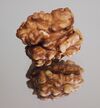 Walnut kernel, halves | |
| Nutritional value per 100 grams | |
|---|---|
| Energy | 2,738 kJ (654 kcal) |
13.71 g | |
| Starch | 0.06 g |
| Sugars | 2.61 g |
| Dietary fiber | 6.7 g |
65.21 g | |
| Saturated | 6.126 g |
| Monounsaturated | 8.933 g |
| Polyunsaturated | 47.174 g 9 g 38 g |
15.23 g | |
| Vitamins | Quantity %DV† |
| Vitamin A equiv. | 0% 1 μg0% 12 μg9 μg |
| Vitamin A | 20 IU |
| Thiamine (B1) | 30% 0.341 mg |
| Riboflavin (B2) | 13% 0.15 mg |
| Niacin (B3) | 8% 1.125 mg |
| Pantothenic acid (B5) | 11% 0.570 mg |
| Vitamin B6 | 41% 0.537 mg |
| Folate (B9) | 25% 98 μg |
| Vitamin B12 | 0% 0 μg |
| Vitamin C | 2% 1.3 mg |
| Vitamin E | 5% 0.7 mg |
| Vitamin K | 3% 2.7 μg |
| Minerals | Quantity %DV† |
| Calcium | 10% 98 mg |
| Iron | 22% 2.91 mg |
| Magnesium | 45% 158 mg |
| Manganese | 163% 3.414 mg |
| Phosphorus | 49% 346 mg |
| Potassium | 9% 441 mg |
| Sodium | 0% 2 mg |
| Zinc | 33% 3.09 mg |
| Other constituents | Quantity |
| Water | 4.07 g |
| |
| †Percentages are roughly approximated using US recommendations for adults. Source: USDA Nutrient Database | |
Walnuts without shells are 4% water, 15% protein, 65% fat, and 14% carbohydrates, including 7% dietary fiber. In a 100-gram reference serving, walnuts provide 2,740 kilojoules (654 kcal) and "rich" amounts (20% or more of the Daily Value or DV) of several dietary minerals, particularly manganese at 163% DV; along with significant amounts of B vitamins.[19]
While English walnuts are the most commonly consumed, their nutrient density and profile are generally similar to those of black walnuts.[20][21]
Unlike most nuts, which are high in monounsaturated fatty acids, walnut oil is composed largely of polyunsaturated fatty acids (72% of total fats), particularly alpha-linolenic acid (14%) and linoleic acid (58%), although it does contain oleic acid as 13% of total fats.[20]
Health claims
In 2016, the US Food and Drug Administration (FDA) provided a qualified health claim allowing products containing walnuts to state: "Supportive but not conclusive research shows that eating 1.5 ounces (43 g) per day of walnuts, as part of a low saturated fat and low cholesterol diet and not resulting in increased caloric intake, may reduce the risk of coronary heart disease."[22] The FDA had, in 2004, refused to authorize the claim that "Diets including walnuts can reduce the risk of heart disease"[23] and had sent an FDA Warning Letter to Diamond Foods in 2010 stating there is "not sufficient evidence to identify a biologically active substance in walnuts that reduces the risk of coronary heart disease."[24] A recent systematic review assessing the effect of walnut supplementation on blood pressure (BP) found insufficient evidence to support walnut consumption as a BP-lowering strategy.[25]
As of 2021, the relationship between walnuts and cognitive health is inconclusive.[26]
Antifungal
Juice from boiled walnuts can be used as an antifungal agent. Green husks can be crushed and sprinkled into the water to poison fish.[27]
Inks and dyes
Walnut husks can be used to make durable ink for writing and drawing. It is thought to have been used by artists including Leonardo da Vinci and Rembrandt.[28]
Walnut husk pigments are used as a brown dye for fabric[29] and were used in classical Rome and medieval Europe for dyeing hair.[30]
Woodworking
The fine, straight-grained wood of the black walnut is highly valued for furniture, wall paneling, automobile interiors, and gunstocks.[31]
Cleaning
The US Army once used ground walnut shells for abrasive blasting to clean aviation parts because of low cost and low abrasive qualities. However, an investigation of a fatal Boeing CH-47 Chinook helicopter crash (11 September 1982, in Mannheim, Germany) revealed that walnut shell grit had clogged an oil port, leading to the accident and the discontinuation of walnut shells as a cleaning agent.[32]
Commercially, crushed walnut shells are still used outside of aviation for low-abrasive, less-toxic cleaning and blasting applications.[33] In the oil and gas industry, deep bed filters of ground walnut shell are used for "polishing" (filtering) oily contaminates from water.[34]
Cat litter
At least two companies, LitterMaid and Naturally Fresh, make cat litter from ground walnut shells.[35][36] Advantages cited over conventional clay litter include environmental sustainability of using what would otherwise be a waste product, superior natural biodegradability, and odor control as good or better than clay litter.[37] Disadvantages include the possibility of allergic reactions among humans and cats.[38]
Folk medicine
Walnuts have been listed as one of the 38 substances used to prepare Bach flower remedies,[39] a herbal remedy promoted in folk medicine practices for its supposed effect on health. According to Cancer Research UK, "there is no scientific evidence to prove that flower remedies can control, cure or prevent any type of disease, including cancer".[40]
In culture
Large, symmetrically shaped, and sometimes intricately carved walnut shells (mainly from J. hopeiensis) are valued collectibles in China where they are rotated in hand as a plaything or as decoration. They are also an investment and status symbol, with some carvings having high monetary value if unique.[41] Pairs of walnuts are sometimes sold in their green husks for a form of gambling known as du qing pi.[42]
Gallery
California black walnut in growth
Walnut in shell and a nutcracker utensil used to break the shell
Georgian snack Gozinaki made from roasted walnuts and honey
References
- ↑ 1.0 1.1 Grant, Amy (19 April 2021). "Walnut Tree Harvesting: When Are Walnuts Ready To Pick". https://www.gardeningknowhow.com/edible/nut-trees/walnut/walnut-tree-harvesting.htm.
- ↑ 2.0 2.1 2.2 "Walnut; Agriculture – Transport Information Service". Association for German Insurance. 2010. http://www.tis-gdv.de/tis_e/ware/nuesse/walnuss/walnuss.htm#toxizitaet.
- ↑ Cosmulescu, Sina Niculina; Trandafir, Ion; Achim, Gheorghe; Botu, Mihai; Baciu, Adrian; Gruia, Marius (15 June 2010). "Phenolics of Green Husk in Mature Walnut Fruits". Notulae Botanicae Horti Agrobotanici Cluj-Napoca 38 (1): 53–56. ISSN 1842-4309. http://www.notulaebotanicae.ro/index.php/nbha/article/view/4624.
- ↑ Cerdá, Begoña; Tomás-Barberán, Francisco A.; Espín, Juan Carlos (2005-01-01). "Metabolism of Antioxidant and Chemopreventive Ellagitannins from Strawberries, Raspberries, Walnuts, and Oak-Aged Wine in Humans: Identification of Biomarkers and Individual Variability" (in en). Journal of Agricultural and Food Chemistry 53 (2): 227–235. doi:10.1021/jf049144d. ISSN 0021-8561. PMID 15656654. https://pubs.acs.org/doi/10.1021/jf049144d.
- ↑ Talapatra, Sunil K.; Karmacharya, Bimala; De, Shambhu C.; Talapatra, Bani (January 1988). "(−)-Regiolone, an α-tetralone from Juglans regia: structure, stereochemistry and conformation" (in en). Phytochemistry 27 (12): 3929–3932. doi:10.1016/0031-9422(88)83047-4. Bibcode: 1988PChem..27.3929T. https://linkinghub.elsevier.com/retrieve/pii/0031942288830474.
- ↑ Ernest Small (2009). Top 100 Food Plants. NRC Research Press. p. 545. ISBN 9780660198583. https://books.google.com/books?id=nyWY_YkV7qAC&pg=PA545.
- ↑ "Commodity Profile: English Walnuts". AgMRC, University of California. 2006. http://aic.ucdavis.edu/profiles/Walnut-2006.pdf.
- ↑ 8.0 8.1 "Walnut (in shell) production in 2021, Crops/Regions/World list/Production Quantity (pick lists)". UN Food and Agriculture Organization, Corporate Statistical Database (FAOSTAT). 2023. http://www.fao.org/faostat/en/#data/QC.
- ↑ (in en) Geoponika - Agricultural Pursuits. 2. London: University of Oxford. 1806. https://archive.org/details/Geoponica02/page/n13/mode/1up.
- ↑ Ibn al-ʻAwwām, Yaḥyá ibn Muḥammad (1864) (in fr). Le livre de l'agriculture d'Ibn-al-Awam (kitab-al-felahah). Paris: A. Franck. pp. 271–276 (ch. 7 - Article 24). OCLC 780050566. https://archive.org/details/lelivredelagric00algoog/page/n14/mode/2up.
- ↑ "Food, Nutrition & Agriculture – Prevention of aflatoxin". FAO, United Nations. 1998. http://www.fao.org/DOCREP/W9474T/W9474T06.HTM.
- ↑ 12.00 12.01 12.02 12.03 12.04 12.05 12.06 12.07 12.08 12.09 12.10 12.11 12.12 12.13 12.14 12.15 12.16 12.17 12.18 12.19 "Walnut Cultivar Table". Fruit and Nut Information Center, Department of Plant Sciences, University of California, Davis. 2018. http://fruitandnuteducation.ucdavis.edu/fruitnutproduction/Walnut/Walnut_Cultivar_Table/.
- ↑ fr:Le Verger Francais tomme II Chapitre I Fruits Locaux & Regionaux 1948
The French en:Orchard Book II Chapter I Local & Regional Fruits 1948 - ↑ & Charles Leslie"Walnut tree named 'Ivanhoe' (patent)" US patent active USPP21718P2, published 2011-02-22, issued 2011-02-22, assigned to THE REGENTS OF THE UNIVERSITY OF CALIFORNIA
- ↑ 15.0 15.1 Le Verger Francais, Tome 1 Catalogue Descriptif des Fruits Adoptes 1947
- ↑ Forsberg, B.; Clark-Warner, M.S.R.D.C.D.E.; Beale, L. (2004). The Complete Idiot's Guide to Terrific Diabetic Meals. DK Publishing. p. 98. ISBN 978-1-61564-486-5. https://books.google.com/books?id=i-VkDQAAQBAJ&pg=PA98. Retrieved 27 May 2017.
- ↑ "Walnut oil recipes". BBC. https://www.bbc.co.uk/food/walnut_oil.
- ↑ Turner, Lisa. "Oil Change". http://www.betternutrition.com/five-essential-oils/food/offtheshelf/963.
- ↑ U.S. Department of Agriculture (2018-10-28). "FoodData Central: Nuts, walnuts, English, halves, raw". https://fdc.nal.usda.gov/fdc-app.html#/food-details/2346394/nutrients.
- ↑ 20.0 20.1 "Nutrition facts: Nuts, walnuts, English dried per 100 g". http://nutritiondata.self.com/facts/nut-and-seed-products/3138/2.
- ↑ "Nutrition facts: Nuts, walnuts, black, dried per 100 g". http://nutritiondata.self.com/facts/nut-and-seed-products/3137/2.
- ↑ "Qualified Claims About Cardiovascular Disease Risk: Walnuts & Heart Disease Docket No. 02P-0292". US Food and Drug Administration. 9 March 2004. https://www.fda.gov/Food/IngredientsPackagingLabeling/LabelingNutrition/ucm073992.htm#cardio.
- ↑ Tarantino, Laura M. (9 March 2004). "Qualified Health Claims: Letter of Enforcement Discretion – Walnuts and Coronary Heart Disease (Docket No 02P-0292)". US Food and Drug Administration, Labeling and Nutrition. https://www.fda.gov/Food/IngredientsPackagingLabeling/LabelingNutrition/ucm072910.htm.
- ↑ Wagner, Roberta (22 February 2010). "FDA Warning Letter to Diamond Food, Inc". US Food and Drug Administration, Inspections, Compliance, Enforcement, and Criminal Investigations. https://www.fda.gov/ICECI/EnforcementActions/WarningLetters/2010/ucm202825.htm. "the evidence supporting a relationship between walnuts and coronary heart disease is related to the omega-3 fatty acid content of walnuts. There is not sufficient evidence to identify a biologically active substance in walnuts that reduces the risk of coronary heart disease. Therefore, the above statement is an unauthorized health claim"
- ↑ Li, Jiayang; Jiang, Bo; O. Santos, Heitor; Santos, Dinamene; Singh, Ambrish; Wang, Lei (November 2020). "Effects of walnut intake on blood pressure: A systematic review and meta‐analysis of randomized controlled trials" (in en). Phytotherapy Research 34 (11): 2921–2931. doi:10.1002/ptr.6740. ISSN 0951-418X. PMID 32510725. https://onlinelibrary.wiley.com/doi/10.1002/ptr.6740.
- ↑ Cahoon, Danielle; Shertukde, Shruti P.; Avendano, Esther E.; Tanprasertsuk, Jirayu; Scott, Tammy M.; Johnson, Elizabeth J.; Chung, Mei; Nirmala, Nanguneri (1 January 2021). "Walnut intake, cognitive outcomes and risk factors: a systematic review and meta-analysis". Annals of Medicine (Informa UK Limited) 53 (1): 972–998. doi:10.1080/07853890.2021.1925955. ISSN 0785-3890. PMID 34132152.
- ↑ (in en-US) The Complete Guide to Edible Wild Plants. New York: Skyhorse Publishing. 2009. pp. 107. ISBN 978-1-60239-692-0. OCLC 277203364. https://www.worldcat.org/oclc/277203364.
- ↑ "Black Walnut Ink Workshop". Guild of Natural Science Illustrators. October 2002. http://www.gnsi.science-art.com/GNSIDC/reports/2002Oct/Oct2002.html.
- ↑ "The Colors of Invention – How to Dye Fibers Naturally". Smithsonian Museum. 13–16 November 1997. http://invention.smithsonian.org/centerpieces/whole_cloth/u3tc/u3materials/dyenatural.html.
- ↑ Sherrow, Victoria (2006). Encyclopedia of Hair: A Cultural History. Greenwood Publishing Group. pp. 267, 355. ISBN 978-0-313-33145-9. https://archive.org/details/encyclopediaofha0000sher. Retrieved 3 July 2014. "walnut."
- ↑ Williams, Robert D. (1980). "Black walnut". US Department of Agriculture. https://www.srs.fs.usda.gov/pubs/misc/ag_654/volume_2/juglans/nigra.htm.
- ↑ "In Re Air Crash Disaster at Mannheim Germany on 9/11/82. Ursula J. Schoenborn, As Executrix of the Estate of Leonedward Schoenborn, Deceased, v. the Boeing Company. Appeal of the Boeing Company. United States Court of Appeals, Third Circuit. 769 F.2d 115". Justia. 1985. http://law.justia.com/cases/federal/appellate-courts/F2/769/115/197097/.
- ↑ "OSHA fact sheet addresses abrasive blasting hazards" (in en). https://www.safetyandhealthmagazine.com/articles/9596-osha-fact-sheet-addresses-abrasive-blasting-hazards.
- ↑ Cheremisinoff, Nicholas P. (2017). Perfluorinated chemicals (PFCs) : contaminants of concern. Hoboken, New Jersey: Wiley. p. 194. ISBN 978-1-119-36353-8.
- ↑ Parks, Shoshi (24 October 2022). "The best natural cat litter we tested with our pets". Insider. https://www.insider.com/guides/pets/best-natural-cat-litter.
- ↑ n.a. (26 May 2023). "What is the best walnut cat litter". Winston-Salem Journal. https://journalnow.com/lifestyles/pets/what-is-the-best-walnut-cat-litter/article_3d870070-7673-50b7-a7a0-5153178b5781.html.
- ↑ n.a. (26 May 2023). "What are the pros of walnut cat litter?". Buffalo News. https://buffalonews.com/lifestyles/pets/what-are-the-pros-of-walnut-cat-litter/article_e72fa3f3-7fb5-52e0-be66-cb42d0a52fbe.html.
- ↑ n.a. (26 May 2023). "What are the cons of walnut cat litter?". SCNow. https://scnow.com/lifestyles/pets/what-are-the-cons-of-walnut-cat-litter/article_5a494202-7aca-5dd2-bb9d-648603fbc08b.html.
- ↑ Vohra, D. S. (1 June 2004). Bach Flower Remedies: A Comprehensive Study. B. Jain Publishers. p. 3. ISBN 978-81-7021-271-3. https://books.google.com/books?id=icG8onA0ys8C&pg=PR3. Retrieved 2 September 2013.
- ↑ "Flower remedies". Cancer Research UK. 26 January 2015. http://www.cancerresearchuk.org/cancer-help/about-cancer/treatment/complementary-alternative/therapies/flower-remedies.
- ↑ Subler, Jason; Lee, Jane Lanhee (28 August 2012). "Status-conscious investors shell out on great walnuts of China". Reuters. https://www.reuters.com/article/us-china-walnuts-idUSBRE87R0NV20120828.
- ↑ Hsieh, I-Yi (13 May 2016). "Asian Anthropology Nuts: Beijing folk art connoisseurship in the age of marketization". Asian Anthropology. doi:10.1080/1683478X.2016.1164354. https://www.academia.edu/25307556.
Further reading
- Ramos, David D. (1997). Walnut Production Manual. UCANR. ISBN 978-1-879906-27-3. https://books.google.com/books?id=yKawaOt88A0C.
- Smith, Jane S. (2009). The Garden of Invention Luther Burbank and the Business of Breeding Plants. Penguin Books. ISBN 978-0-14-311689-9.
External links
 |
 KSF
KSF